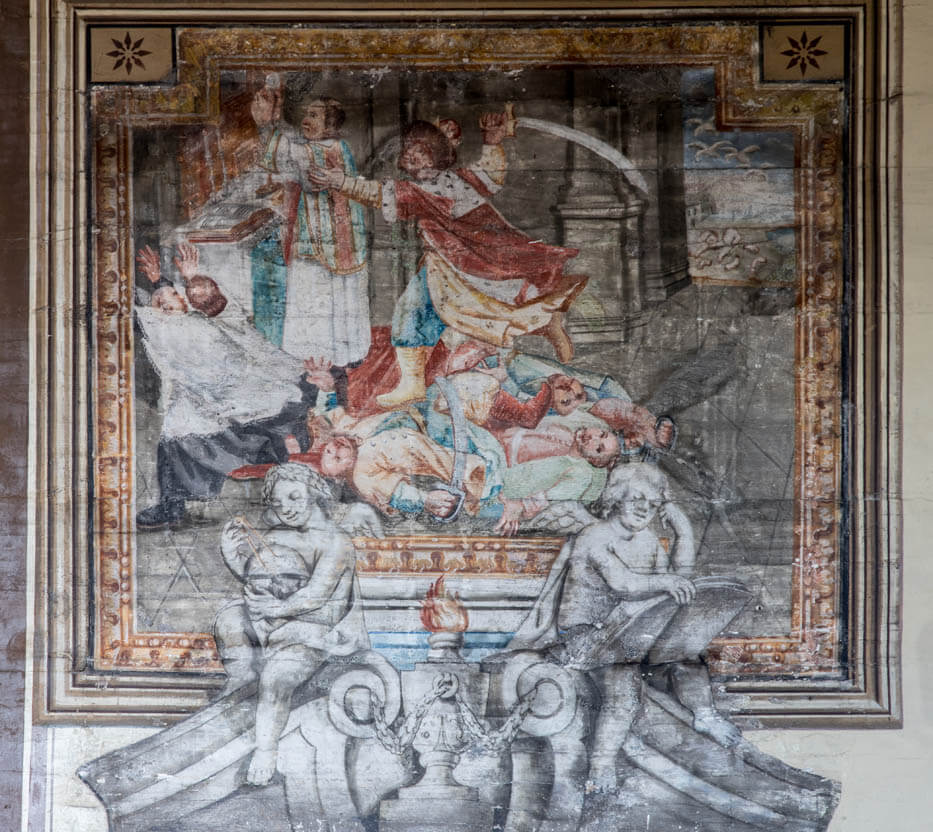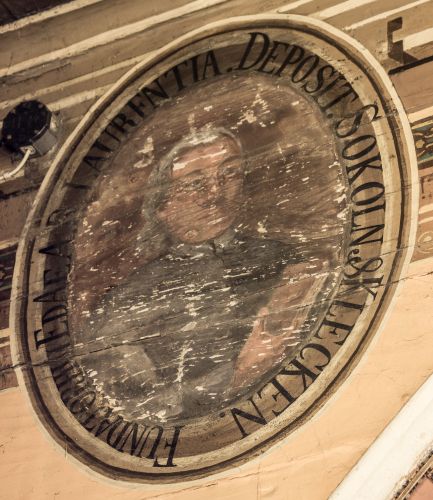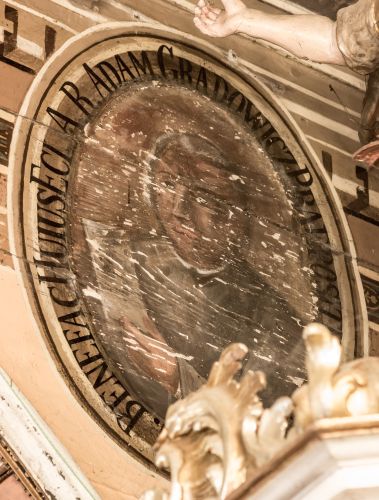
Church of St. Stanislaus the Bishop and Martyr
Date of construction: 1682-1712Monuments
The murder of the bishop
The church is Sokolniki is characterized by a beautifully painted interior. Polychromies were made in 1787 by Ignacy Ocaszalski. A fragment of the painting shows “The Martyrdom of St. Stanislaus” to whom the parish is dedicated. St. Stanislaus, whose name means “become famous”, was born in 1030 in the village Szczepanowo. From the chronicle of the annalist Wincenty Kadłubek we learn that the bishop was in conflict with the king Bolesław the Bold: he criticized the king’s attitude towards the subjects, he rebuked the king and asked Bolesław to come to his senses. He was sentenced to martyr’s death by having his limbs cut off. According to the chronicler, hot-headed king killed the disobedient clergyman by himself and cut his body to pieces with a sword.

Here contending for justice,
He did not yield before the anger of the king:
Because he constantly reminded
The tyrant of his brutality,
He gained the crown of a martyr,
And fell quartered into pieces.
The Heavens wrought a new miracle,
For the Celestial Physician by His power
The martyr’s quartered body
Once more miraculously joined into whole.
A fragment of 13th-century song
Gaude Mater Polonia
Wincenty of Kielcza (1200-1262)
Over time the cult of St. Stanislaus developed and the bishop was thought to be the patron saint of Poland. The legend of his limbs miraculously fused together with the body had gained special importance. He was considered to be a symbol of the permanence of the state, which united after the feudal fragmentation. Probably the canonization of the saint Wincenty of Kilecza wrote a hymn “Gaude Mater Polonia prole fecunda nobili” (Rejoice, oh Mother Poland, rich in noble offspring) – the song tells about the bishop’s service, his martyrdom and miracles which took place after his death.
How the altar was built
The most important elements of the church’s furnishings are the main altar and a tabernacle inside it. Due to the easiness of processing, the cost and the material’s availability they were made of wood. The process of the creation of an altar can be divided into stages. The most important is the collection of the material: wood has to be seasoned properly. The next stage is the removal of knots and the elimination of all roughness. Then on a polished surface a mixture of adhesive-chalk is spread, which is later decorated with ornaments and everything is polychromed, that is painted.
Gates on the left and the right sides of the altar allow to walk around it (this solution is modelled on stone churches which possessed the ambulatory).
Images of Moses and Aaron in laurel wreaths are put above the gates.
In the centre there is a painting of the Mother of God with Child and at the bottom the scene of St. Stanislaus the Bishop’s murder was painted. The composition of the scene was copied from the wall polychromy and changed slightly by adding witnesses of the event – standing men in Sarmatian clothing and a dismembered body of the bishop above the group of figures.

Mensa – altar plate, often in a shape of a box or a sarcophagus, covered by three linen tablecloths which resemble white sheets which enveloped the body of Christ in the grave.
Tabernacle – a reference to a tent where the Israelites kept the Ark of Covenant (Latin tabernaculum – ‘tent’), a richly decorated cabinet used for keeping of consecrated Hosts – the central point of a church.
Retable – a kind of an altarpiece. These were usually paintings, sculptures or gold objects, or elements which imitated architectural details put in decorated frames.
Predella – a rectangular element of an altar, the base for the altarpiece standing on the mensa.
To commemorate
Behind the altar a unique inscription in Latin was placed, which does not appear anywhere else, and which relates to the restoration of the church in 1772 by a priest Andrzej Kosmaciński.

“This church was founded by the faithful in 1682 and when it dilapidated in time it was restored by the most reverent Andrzej Kosmaciński, the doctor of philosophy at the University of Kraków, the rector of Sokolniki and the dean of Gniezno by the church of Apostles St. Peter and St. Paul. In addition, he has recently founded the tower, the two chapels, the vestry and two brick niches. He also ordained many robes thanks to the help of the faithful. Then in 1787 he decorated his beloved church in Sokolniki with beautiful paintings. May God show him His mercy by the prayers of the parishioners and the neighboring people. Once again in 1886 the church was restored with the help of all parishioners and beautifully painted by the effort of the most reverent Paweł Iwicki and the patron of the church noble sir Franciszek Kruszyński, the owner of Sokolniki estate. It was painted by Bernard Gąsienicki and Bolesław Zwolski of Gniezno.”
The founders of the church
On the rood wall on the chancel side portraits of the church’s founders were placed. One of them was the rector Adam Gradowicz who was also the rector of the school of St. Mary Magdalene by the Cistercian church in Wągrowiec. He was an extremely colorful character of the 17th century world, he was a philanthropist, and above all, a booklover. He gathered a valuable book collection which included theological, philosophical, historical and poetic works. Eighteen invaluable old prints which belonged to Gradowicz have preserved until today, among them one of the oldest publications of Aristotle (edition form 1545) or Erasmus of Rotterdam (from 1549).
The co-founder of the church in Sokolniki together with Adam Gradowicz was Wawrzyniec Kłosowski. His image was also placed in the medallion on the rood wall.



